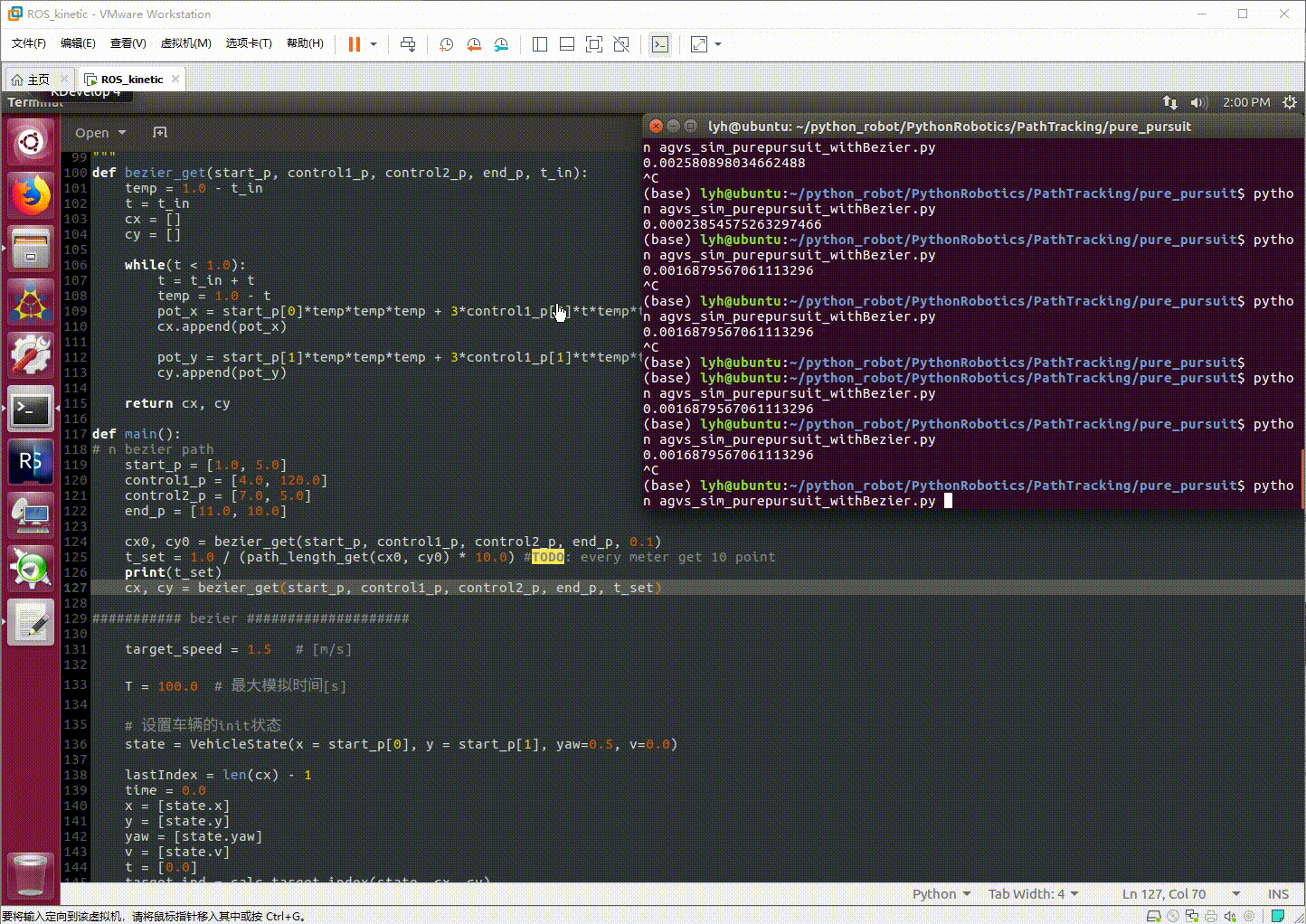一、Pure Pursuit算法模型图解和公式推导
下图分析的双舵轮AGV的运动学模型,是按照前后舵轮均安装在车体中心线上的车型分析的,当然其它结构的车型也可以按照这样的分析方法画出如下图解。

符号 | 物理量 |
r(m) | 车体中心(小圆)转弯半径 |
R(m) | 车轮(大圆)转弯半径 |
L(m) | 轴距 |
δ(rad) | 前轮转角 |
α(rad) | 车身与预瞄点夹角 |
Ld(m) | 预瞄距离 |
e(m) | 与预瞄点的横向偏差 |
Xr(m) | 预瞄点横坐标 |
Yr(m) | 预瞄点纵坐标 |
通过正弦定理推导:

即

则可推导出 转弯圆弧的曲率k :

还可得到:


即可推导出:(重要)

由上式可知,本控制器的本质是对 转角进行控制 ,以减少横向误差为目标的横向控制器。其中,

可视为控制器的 P参数 。 L 为车辆的 轴距 , Ld 为设定的 预瞄距离 。 本控制器的控制效果主要取决于预瞄距离的选取,一般来说预瞄距离越长,控制效果会越平滑,预瞄距离越短,控制效果会越精确(同时也会带来一定的震荡)。 预瞄距离的选取也和当前车速有关 。
通常来说ld 被认为是车速的函数,在不同的车速下需要选择不同的前视距离。
一种最常见的调整前视距离的方法就是将前视距离表示成 车辆纵向速度 的线形函数,即 Ld=k*Vx ,那么前轮的转角公式就变成了:

于是纯追踪控制器的参数调整就变成了调整 前视系数k 。常来说,会使 用最大、最小前视距离 来 约束前视距离 ,越大的前视距离意味着轨迹的追踪越平滑,小的前视距离会使得追踪更加精确(当然也会带来控制的震荡)。
而两轮转角对应的角速度W,根据当前控制速度V可得:

- 非线性的预瞄距离选取方式
在有些文献中, 预瞄距离的选取方式 表现为如下形式(二次方程):

上式中,对于常数A:

amax为 最大制动加速度 。 Av2表示 最短车辆制动距离 。 B表示车辆 遇到异常时需要的反应时间 , Bv则为 对应的反应距离 ,C表示 车辆的最小转弯半径 。
- 实际应用总结
在实际应用中,Pure Pursuit算法通常 不要求跟踪的目标点到本车中心的距离切实等于预瞄距离。 而是会选择 采样好的一系列目标点中到中心距离最接近预瞄距离的那个点来 近似跟踪 。这样做的好处是可以 不需要目标轨迹的函数方程来求解真实预瞄距离坐标 ,极大地提升了算法的效率。
实践中, 纵向控制Vx 通常使用一个简单的 P控制器 , 横向控制 (即转角控制)我们使用 纯追踪控制器 。
二、python实现三阶贝塞尔曲线跟踪
三阶 贝塞尔曲线路径生成以及轨迹跟踪仿真:
import numpy as np
import math
import matplotlib.pyplot as plt
k = 0.1 # 前视距离系数
Lfc = 0.5 # 前视距离
Kp = 1.0 # 速度P控制器系数
dt = 0.1 # 时间间隔,单位:s
L = 0.68 # 车辆轴距,单位:m
class VehicleState:
def __init__(self, x=0.0, y=0.0, yaw=0.0, v=0.0):
self.x = x
self.y = y
self.yaw = yaw
self.v = v
# 双舵轮车型的状态更新函数(模拟里程计)
def update(state, a, delta):
##
state.x = state.x + state.v * math.cos(state.yaw) * dt
state.y = state.y + state.v * math.sin(state.yaw) * dt
# state.yaw = state.yaw + state.v / L * math.tan(delta) * dt
state.yaw = state.yaw + state.v / (L*0.5) * math.tan(delta) * dt #TODO:车体中心为运动半径, v + w*dt
state.v = state.v + a * dt
return state
#p速度控制器,平滑小车前向速度
def PControl(target, current):
a = Kp * (target - current)
return a
# 纯跟踪算法控制器,输出为角速度(双舵轮的两个舵向角)、路点索引值
def pure_pursuit_control(state, cx, cy, pind):
ind = calc_target_index(state, cx, cy)
# pind:上一个路点索引值
if pind >= ind:
ind = pind
if ind < len(cx):
# tx、ty:车子所在(近似)路径上的点
tx = cx[ind]
ty = cy[ind]
else:
tx = cx[-1]
ty = cy[-1]
ind = len(cx) - 1
alpha = math.atan2(ty - state.y, tx - state.x) - state.yaw #车身与预瞄点夹角
if state.v < 0: # back
alpha = math.pi - alpha
Lf = k * state.v + Lfc # 前视距离*时间系数
# delta = math.atan2(2.0 * L * math.sin(alpha) / Lf, 1.0)
delta = math.atan2(L * math.sin(alpha) / (Lf*Lf), 1.0) #TODO:双舵轮转角进行控制
return delta, ind
# 搜索最临近车体的路点
def calc_target_index(state, cx, cy):
dx = [state.x - icx for icx in cx]
dy = [state.y - icy for icy in cy]
d = [abs(math.sqrt(idx ** 2 + idy ** 2)) for (idx, idy) in zip(dx, dy)]
ind = d.index(min(d))
L = 0.0
Lf = k * state.v + Lfc
while Lf > L and (ind + 1) < len(cx):
dx = cx[ind + 1] - cx[ind]
dy = cx[ind + 1] - cx[ind]
L += math.sqrt(dx ** 2 + dy ** 2)
ind += 1
return ind
"""
三阶贝塞尔曲线
"""
def bezier_get(start_p, control1_p, control2_p, end_p, t_in):
# t为微分系数,0.01表示
temp = 1.0 - t_in
t = t_in
cx = []
cy = []
while(t < 1.0):
t = t_in + t
temp = 1.0 - t
pot_x = start_p[0]*temp*temp*temp + 3*control1_p[0]*t*temp*temp + 3*control2_p[0]*t*t*temp + end_p[0]*t*t*t
cx.append(pot_x)
pot_y = start_p[1]*temp*temp*temp + 3*control1_p[1]*t*temp*temp + 3*control2_p[1]*t*t*temp + end_p[1]*t*t*t
cy.append(pot_y)
return cx, cy
def main():
# n bezier path
start_p = [1.0, 5.0]
control1_p = [4.0, 8.0]
control2_p = [7.0, 5.0]
end_p = [11.0, 10.0]
cx, cy = bezier_get(start_p, control1_p, control2_p, end_p, 0.01)
########### bezier ####################
target_speed = 1.5 # [m/s]
T = 10.0 # 最大模拟时间[s]
# 设置车辆的init状态
state = VehicleState(x = start_p[0], y = start_p[1], yaw=0.5, v=0.0)
lastIndex = len(cx) - 1
time = 0.0
x = [state.x]
y = [state.y]
yaw = [state.yaw]
v = [state.v]
t = [0.0]
target_ind = calc_target_index(state, cx, cy)
while T >= time and lastIndex > target_ind:
ai = PControl(target_speed, state.v)
di, target_ind = pure_pursuit_control(state, cx, cy, target_ind)
state = update(state, ai, di)
time = time + dt
x.append(state.x)
y.append(state.y)
yaw.append(state.yaw)
v.append(state.v)
t.append(time)
plt.cla()
plt.plot(cx, cy, ".r", label="course")
plt.plot(x, y, "-b", label="trajectory")
plt.plot(cx[target_ind], cy[target_ind], "go", label="target")
plt.axis("equal")
plt.grid(True)
plt.title("Speed[m/s]:" + str(state.v)[:4])
plt.pause(0.001) # odom 1000Hz
plt.show()
if __name__ == '__main__':
main()注意点:
需要pip安装 numpy 、 matplotlib 等 ,可以直接按照我的另一篇博文推介的开源项目安装(强烈安利这个开源项目,机器人各方面的算法都有涉及)。

- 顺便放一个成品效果演示,工程化实现,用任务管理方式实现了直线、贝塞尔曲线、旋转、自然导航等子任务的顺序执行,任务指令使用json方式下达(代码不开放,有问题可以问)。
双舵轮AGV纯跟踪算法仿真演示



















